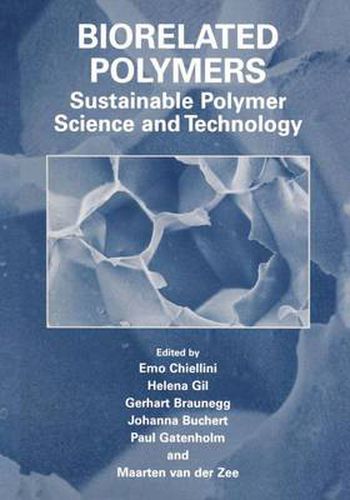Readings Newsletter
Become a Readings Member to make your shopping experience even easier.
Sign in or sign up for free!
You’re not far away from qualifying for FREE standard shipping within Australia
You’ve qualified for FREE standard shipping within Australia
The cart is loading…






This title is printed to order. This book may have been self-published. If so, we cannot guarantee the quality of the content. In the main most books will have gone through the editing process however some may not. We therefore suggest that you be aware of this before ordering this book. If in doubt check either the author or publisher’s details as we are unable to accept any returns unless they are faulty. Please contact us if you have any questions.
This work is the combined proceedings of the First and Second International Conferences on Biopolymer Technology, organized by the International Centre of Biopolymer Technology, held in Coimbra, Portugal, on September 29 - October 1, 1999, and in Ischia (Naples), Italy, on October 25-27, 2000. This book includes papers on polymeric materials from renewable resources known as Biorelated Polymers and Plastics , and issues are bound to their utilization and environmental impact in their production, conversions to manufacts and ultimate disposal of post-costume manufacts. Modern industrial developments inspired by the new concepts of sustainability and ecocompatibility require a deeper attention to renewable resources as a new-old source of raw material and feedback. This new trend, occurring not only in industrialized countries but also in emerging countries and countries in transition, thoroughly permeates the polymer and plastic industry, due to the big impact that those materials have on the modern way of life. Plastic waste, specifically that stemming from segments of packaging, containers for solids and liquids and single use items, is attracting much effort from municipality officers, producers and converters, aimed at finding a harmonized solution among the various options available for their appropriate management. In this respect, polymeric materials of natural origin (biopolymers), as well as materials from renewable resources useable for the production of monomeric precursors, or semi-synthetic polymeric materials, constitute a focal point for future industrial development in the production of polymers and plastics. The present book contains much valuable information and scientific hints on a modern approach aimed at designing processes and products with minimal negative environmental impact.
$9.00 standard shipping within Australia
FREE standard shipping within Australia for orders over $100.00
Express & International shipping calculated at checkout
This title is printed to order. This book may have been self-published. If so, we cannot guarantee the quality of the content. In the main most books will have gone through the editing process however some may not. We therefore suggest that you be aware of this before ordering this book. If in doubt check either the author or publisher’s details as we are unable to accept any returns unless they are faulty. Please contact us if you have any questions.
This work is the combined proceedings of the First and Second International Conferences on Biopolymer Technology, organized by the International Centre of Biopolymer Technology, held in Coimbra, Portugal, on September 29 - October 1, 1999, and in Ischia (Naples), Italy, on October 25-27, 2000. This book includes papers on polymeric materials from renewable resources known as Biorelated Polymers and Plastics , and issues are bound to their utilization and environmental impact in their production, conversions to manufacts and ultimate disposal of post-costume manufacts. Modern industrial developments inspired by the new concepts of sustainability and ecocompatibility require a deeper attention to renewable resources as a new-old source of raw material and feedback. This new trend, occurring not only in industrialized countries but also in emerging countries and countries in transition, thoroughly permeates the polymer and plastic industry, due to the big impact that those materials have on the modern way of life. Plastic waste, specifically that stemming from segments of packaging, containers for solids and liquids and single use items, is attracting much effort from municipality officers, producers and converters, aimed at finding a harmonized solution among the various options available for their appropriate management. In this respect, polymeric materials of natural origin (biopolymers), as well as materials from renewable resources useable for the production of monomeric precursors, or semi-synthetic polymeric materials, constitute a focal point for future industrial development in the production of polymers and plastics. The present book contains much valuable information and scientific hints on a modern approach aimed at designing processes and products with minimal negative environmental impact.